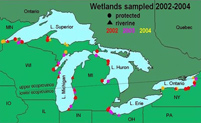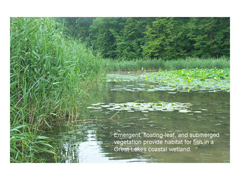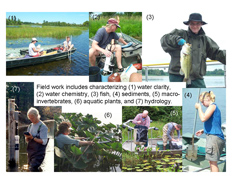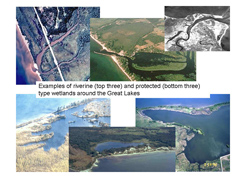Habitat - Fish Relationships in Great Lakes Coastal Wetlands
Project Summary


EPA's Mid-Continent Ecology Division (MED) is studying relationships between fishes and habitat in coastal wetlands of the Great Lakes, as part of a larger NHEERL program to provide the science needed to develop habitat-based criteria for protection of coastal ecosystems. Many Great Lakes fishes depend directly or indirectly on wetlands (Fig. 1), and habitat alteration is an important threat. The research is integrated with MED nutrient research on these same wetlands, and is coordinated with work by the EPA-funded Great Lakes Ecological Indicators consortium (GLEI). We collected data from 58 coastal wetlands over the summers of 2002, 2003, and 2004. Wetlands were distributed across all five Great Lakes and the upper and lower geographical ecoprovince (Fig. 2), included both riverine and protected type wetlands (Fig. 3), and spanned a gradient in nutrient loading, as inferred from agricultural practices in the wetland watersheds. Data obtained includes detailed information on wetland fish assemblages (species composition, size structure) and habitat (including wetland morphology and hydrology, water quality, and aquatic plant structure -- Fig. 4), as well as characteristics of the surrounding watersheds (watershed characterization completed by our GLEI collaborators). Analyses are underway to understand patterns in fish assemblages and wetland habitat components and the influence of anthropogenic stressors on these relationships.


Internet home page of GLEI collaborators at UMD's Natural Resources Research Institute: http://glei.nrri.umn.edu/
Key products
Our research objectives/approaches and initial results have been presented
at various national meetings. Data analysis and generation of manuscripts is
in progress. Completed publications from the fish-habitat work and the related
nutrient work include:
Morrice, J.A., N.P. Danz, R.R. Regal, J.R. Kelly, J.G. Niemi, E.D. Reavie, T.
Hollenhorst, R.P. Axler, A.S. Trebitz, A.M. Cotter, and G.S. Peterson. 2008. Human
influences on water quality in Great Lakes coastal wetlands. Environmental
Management 41:347-357.
Morrice, M.A., A.S. Trebitz, J.R. Kelly, A.M. Cotter, and M.L. Knuth. 2008. Variability in nutrient levels within and among coastal wetlands of the Lake Superior south shore: role of hydrology and landscape. In: State of Lake Superior, M. Munawar, Ed., Ecosystem World Monograph Series. in press.
Brazner, J.C., N.P. Danz, G.J. Niemi, R.R. Regal, A.S. Trebitz, R.W. Howe, J.M. Hanowski, L.B. Johnson, J.J.H. Ciborowski, C.A. Johnston, E.D. Reavie, and G.V. Sgro. 2007. Evaluation of geographic, geomorphic, and human influences on Great Lakes wetland indicators: a multi-assemblage approach. Ecological Indicators 7:610-635.
Brazner, J.C., N. Danz, A.S. Trebitz, G. Niemi, R. Regal, T. Hollenhorst, G. Host, E.D. Reavie, T. Brown, J. Hanowski, C. Johnston, L. Johnson, R.W. Howe, and J. Ciborowski. 2007. Responsiveness of Great Lakes wetland indicators to human disturbances at multiple spatial scales: a multi-assemblage assessment. Journal of Great Lakes Research 33(si3)42-66.
Peterson, G.S., M.E. Sierszen, P.M. Yurista, and J.R. Kelly. 2007. Stable nitrogen isotopes of plankton and benthos reflect landscape-level influences on Great Lakes coastal ecosystems. Journal of Great Lakes Research 33(si3):27-41.
Trebitz, A.S., J.C. Brazner, V.J. Brady, R. Axler, and D.K. Tanner. 2007. Turbidity tolerances of Great Lakes coastal wetland fishes. North American Journal of Fisheries Management 27:619-633.
Trebitz, A.S., J.C. Brazner, A.M. Cotter, M.L. Knuth, J.A. Morrice, G.S. Peterson, M.A. Sierszen, J.A. Thompson, and J.R. Kelly. 2007. Water quality in Great Lakes coastal wetlands: Basin-wide patterns and response to an anthropogenic disturbance gradient. Journal of Great Lakes Research 33(si3):67-85.
Trebitz, A.S. and D.L. Taylor. 2007. Exotic and invasive aquatic plants in Great Lakes coastal wetlands: distribution and relation to watershed land use and plant richness and cover. Journal of Great Lakes Research. 33:705-721.
Hill, B.H., C.M. Elonen, T.M. Jicha, A.M. Cotter, A.S. Trebitz, and N.P. Danz. 2006. Sediment microbial enzyme activity as an indicator of nutrient limitation in Great Lakes coastal wetlands. Freshwater Biology 51:1670-1683.
Sierszen, M.E., G.S. Peterson, A.S. Trebitz, J.C. Brazner, and C.W. West. 2006. Hydrology and nutrient effects on food web structure in ten Lake Superior coastal wetlands. Wetlands 26:951-964.
Trebitz, A.S. 2006. Characterizing seiche and tide-driven daily water level fluctuations affecting coastal ecosystems of the Great Lakes. Journal of Great Lakes Research 32:102-116.
Trebitz, A.S., J.A. Morrice, D.L. Taylor, R.L. Anderson, C. West, and J.R. Kelly. 2005. Hydromorphic determinants of aquatic habitat variability in Lake Superior coastal wetlands. Wetlands 25:505-519.
Project personnel
| Name | Phone | |
| Anett Trebitz | trebitz.anett@epa.gov | 218-529-5209 |
| Mike Sierszen | sierszen.mike@epa.gov | 218-529-5199 |
| Jo Thompson | ||
| Greg Peterson | ||
| Mark Pearson | ||
| Anne Cotter | ||
| Mike Knuth | ||
| Brian Hill | ||
| Jack Kelly |
Research project update date
June 16, 2011
![[logo] US EPA](../gif/logo_epaseal.gif)